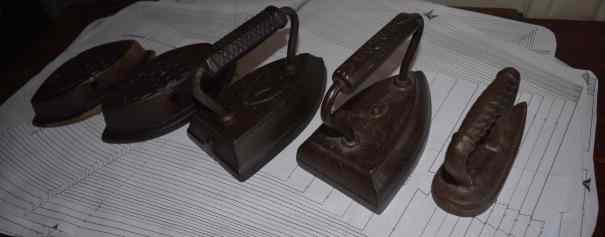I sew with treadle sewing machines, so if the power goes out, I can just keep on sewing. However, most of the time when I’m sewing I also need to iron, so I thought it would be nice to have a sad iron that I can heat up on the wood stove. I put off getting one, since it seemed silly to buy something I would only use once a year or so at the most, but then I realized that sad irons would also make perfect heavyweight pattern weights that I could use year round, so I went ahead and got some. Plus they are just fun to look at.
Most of the patterns I use are either pdfs printed onto printer paper or patterns traced onto butcher paper. Pinning thicker paper onto fabric doesn’t work well at all, so I hold down patterns with weights, then either trace around the patterns or cut around them with scissors or a rotary cutter. I like to use small weights around the edges of the pattern, but for large pattern pieces, it’s also nice to have a couple of heavy pattern weights that hold the pattern firmly in place so there’s no chance the pattern will shift.
I looked at new sad irons designed for off-grid users, and uh, no, I wasn’t going to pay that much for a single iron. Then I looked at antique sad irons on ebay, where there are some reasonable prices for sad irons (although shipping costs can be high), but also some sellers who seem to think that anything old is worth its weight in gold. I found my irons on the shopgoodwill auction site, and including shipping they ended up around $10 each, which is less than the prices I’ve seen for professional pattern weights.
I got the kind of irons with attached iron handles, since the old wood ones tend to break. I also ended up with two bases for Asbestos brand irons. They are a little hard to pick up without handles, but the detachable handles are where the asbestos was, which I of course don’t want, so I’ll just have to be careful when I use those ones as pattern weights. They are 4.5 to 5 pounds each, so I’d probably break a toe if I dropped one on my foot.
The small iron on the right in the photo below looks like it will be perfect for the type of pressing I do while sewing – mostly pressing seam allowances and pressing up hems.
Sad irons are made from cast iron, so they rust if they are not properly seasoned. They are seasoned with oil just like you would season a cast iron cooking pan. Most of the irons I got were in pretty good shape, but I did have to use a pumice stone and a wire brush to get some rust off of a couple of them.
If the seasoning is done properly, you end up with a hard non-stick surface on the iron. The first time I tried seasoning my irons I didn’t do things right. I looked up directions for seasoning cast iron pans, so I thought I knew what to do. I rubbed palm oil on the irons, then baked them at 450° F for an hour and a half. I ended up with a sticky, greasy mess. The thick brown oil residue rubbed off, leaving brown stains, which obviously wasn’t going to work for ironing fabric.
I did some more research to figure out what I did wrong, and found this blog post on seasoning cast iron pans. It turns out that most of the directions you will find online for seasoning cast iron pans are flat-out wrong. The key to success is to use a very thin layer of flax oil, then bake at a high temperature. To get a thick enough coating, you repeat the process several times. I scrubbed the greasy brown residue off my irons and tried again with flax oil, with perfect results. The coating on the irons is black, hard, non-stick, and doesn’t rub off.
I have cast iron frying pans that I rarely use because food sticks to them, but I think I might re-season them too now that I know how to do it right.



 GrowYourOwnClothes Etsy Shop
GrowYourOwnClothes Etsy Shop
What a great idea. I have a couple of these kicking around somewhere, I might need to track them down!
LikeLike